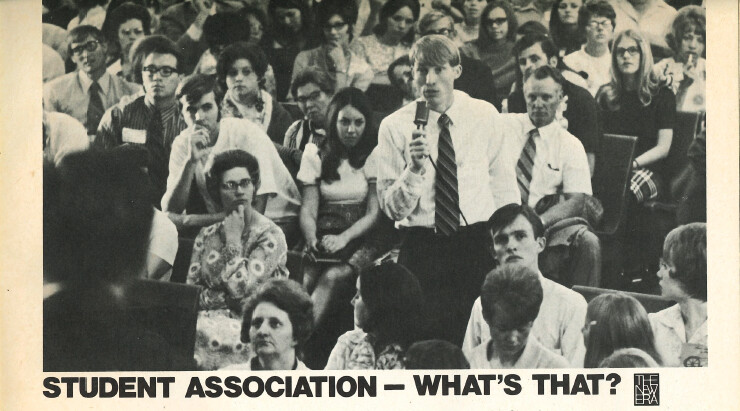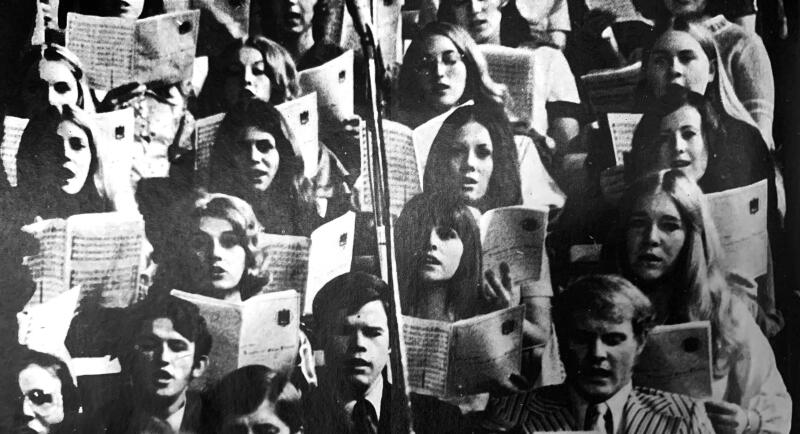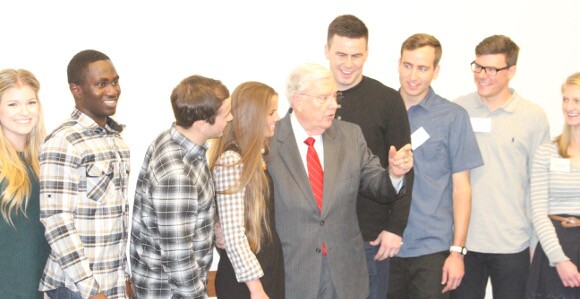Oh, the YSA ward. There can be a lot of feelings about those words, right? Some have fond feelings for them, others, well … not so much.
But wherever you lie on the spectrum, we’d be willing to bet your next linger longer that most Latter-day Saints who go to YSA wards today have no idea how they came to be. And yet YSA wards have a meaningful presence in the Church and are now found worldwide from New Zealand to Latin America. Curious about the early days of YSA wards? Here’s a look at how they’ve evolved over the years.
▶You may also like: First ever YSA ward in Tonga created
A Singles Ward? No Such Thing
Although the Brigham Young University 1st Ward was created for college students in 1956, and student wards, branches, and stakes are mentioned in the 1968 General Handbook of Instructions, single adult wards weren’t created for the entire Church until decades later. In the interim, young single adult programs were developed to connect Latter-day Saints to each other and to the gospel. But again, college students were the focus at first, as they were shifting to university campus life.
“Going to college today doesn’t mean leaving the Church circle. The Church is going to college too,” according to a September 1971 New Era article. “You can choose a campus close to home or one far away and still have the influence of the Church in your life.”
At the time, students could stay connected to the Church through the Student Association, which was established by the First Presidency “to assist students to continue growing spiritually while achieving academically,” the New Era article explains. A General Authority served as managing director of the Student Association and was assisted by a stake president in the region as well as an institute of religion teacher.

A student council, which included a president, members of Church fraternities and sororities, servicemen, returned missionaries, representatives of women’s affairs, and others, discussed the needs of students on campus. They then determined which group represented on the council could help meet those needs. The Student Association also coordinated activity dates with other Church-sponsored events “so that there [was] no overlap in timing or type of involvement.”
Hello, Young Adult Activities
In 1973, a significant change was made to a Churchwide organization that seems to have been another step toward singles wards. The words “Mutual Improvement Associations” might sound familiar to many young adults today from their days in the young men or young women programs—or due to a certain dating app—but the word’s relevance to single adults requires a further look back into Church history.
According to BYU Library’s Special Collections, “Mutual Improvement Associations … or MIA, were organized by the Church to benefit young men and young women” and were established in 1869 and 1875 for young women and young men, respectively. But the age limit for the program wasn’t exactly what it is today—for instance, in 1913 men age 22 and older were “advanced seniors” in the program, and age divisions in the program evolved over time, Church History Topics explains.
The MIA, according to BYU Library Special Collections, provided “recreational and faith-promoting activities for youth” like dances and trainings. But according to a New Era article, in 1973 the program was divided into two programs—one for the youth, and one for young adults—to “meet the increasing demands of a fast-growing, worldwide Church.”
The name “Mutual Improvement Association,” along with its acronym, stuck around for young women and young men. But what was the program’s name for young single adults? It was nearly identical as the one it just broke off from and was called the Mutual Interest Association. The bigger difference between the two was that for youth, the name was technically the “Aaronic Priesthood MIA” and for single adults it was the “Melchizedek Priesthood MIA,” because, the announcement explained, it would give the programs “increased priesthood identity.”
According to the New Era article, the new young single adult program was designed to make activities for young adults ages 18 through 25 and those age 26 and older (called “special interest groups”) more effective. Though the article doesn’t expressly state the reason behind the change, it’s likely that dividing the groups by age would better suit their needs. But what about the Student Association for college students that the First Presidency established not long before? It continued teaching Latter-day Saint students and helped coordinate activities. But now all of its activities would be part of the “overall Young Adult program.”
With this change, young adults were also organized on a stake, region, or area basis—but not as single adult wards with congregations as we know them today. Still, this change moved things in that direction since the program now included all young adults and not just students.
Wait … Why Are We Really Doing This?
Four members of the Quorum of the Twelve were advisers of this new young adult Mutual Interest Association: Elders Thomas S. Monson, Boyd K. Packer, Marvin J. Ashton, and Bruce R. McConkie. A committee of assistants—Elders James E. Faust, Marion D. Hanks, and L. Tom Perry—were under them.
In September 1973, the Ensign published statements from the assistants of the new program. As part of his message, Elder Faust said that “there is much in Melchizedek Priesthood MIA that is not of organization nor program, but rather of spirit and a reaching toward a second birth and a reawakening, followed by an eternal searching for that which is noble and good.”
Elder Perry wrote of the historic nature of the changes, saying, “These programs … are individually tailored and specially designed to meet the needs of the great single members of the Church. Their ride on the stream of life has been rougher than most and at times they have found themselves on tributaries lined with sharp rocks, rapids, and swift currents that have tossed them to and fro. Now this program cuts a channel and will allow them to come into the mainstream of the Church where the waters are deep and the ride can be smooth, with many new ports of opportunity in study, activity, service, and spirituality.”

And Elder Marion D. Hanks explained that listening to members played an important part in the creation of the program. He wrote:
“The programs we are talking about involve our discovering what those needs are by listening. It has been written that we cannot really love anyone—that is, act toward them in a way that would foster their well-being and happiness—unless we know what they need; and we cannot know what they need unless they tell us, and we listen. Our programs involve listening, getting a response, some assessment from them of their own understanding of their needs, what they would like, what they are willing to do, how far they are willing to reach. Our responsibility is to reach out to them.”
Young Adults, Young Special Interest, and Special Interest—Oh, My
In his October 1975 Relief Society general conference address, Elder David B. Haight shared a few details about the Melchizedek Priesthood MIA program. He explained that it wasn’t an auxiliary organization and that meetings were held under the direction and leadership of the priesthood. There were also several age groups that were part of the program: Young Adults, Young Special Interest, and Special Interest.
The program’s reach extended beyond Utah, too; Elder Haight spoke of a Special Interest leader in California who said the area was having success in attracting “active and inactive people to the activities.”
While some of those activities were social events that included things like dance festivals, original dramatic productions, Heritage Fairs, and Bicentennial Balls, many activities included service. In a 1976 report, Elder L. Tom Perry spoke of the projects youth and single adults collectively had been a part of:
“From all over America we find articles with bold headings such as ‘Youth Group Cleans up the Canyon,’ ‘Young Adult Organization Paints and Cleans up City Park,’ ‘The Special Interests Group Restores Historic Monuments.’ Our last survey on volunteer service hours made just before the Fourth of July indicates that we had passed the 6 million man-hour mark. The majority of this service has been contributed by our youth, young adults, and special interest groups. Our hats are off to you for your major accomplishment.”
At this time, single adult branches could also be organized at the request of a stake president. According to the 1976 General Handbook of Instructions, if there were 200 unmarried adults ages 18 to 35 in the stake that were not living with their parents and “no new buildings are required to house such a branch,” then that approved branch would be part of a resident stake rather than the campus stake. But the official organization of single adult wards was still to come.
So Long, MIA
Although the new MIA program had clearly been a success, in the August 1977 Ensign an article explained that a Church regional meeting was held, during which the name Melchizedek Priesthood MIA was discontinued. The joint Special Interests, Young Special Interests, and Young Adults programs were also now simply called the “Program for Single Adults.”
This program had some significant organizational changes: A new Stake Committee for Single Adults was formed, with a member of the stake presidency and stake Relief Society as the chairman and vice-chairman. There were also stake councils for different age groups that had a high council and Relief Society Board member advising each one. And the organization extended to the ward level, involving members of the elders quorum and Relief Society presidencies as well as representatives from the elders quorum and Relief Society.
“There now exists a strong and effective ‘team’ of priesthood, Relief Society, and peer leaders at both the stake and ward levels, working together,” the announcement reads. “Peer leaders in the Special Interest, Young Special Interest, and Young Adult programs will continue to plan and carry out their special activities as approved by local priesthood and Relief Society leaders—programs such as home evening groups, interest groups, service projects, firesides, Pursuit of Excellence, and other social, cultural, and recreational activities.”

All the Single Saints
Despite the efforts the Church made to adjust its program for singles over the years, members were still figuring out how to make the program function as they went along—and some old names seem to have stuck around for a while.
“If Special Interests people don’t have a program going, then it’s up to them to get one going,” Rosy Powell, a Special Interests leader in Rochester, New York, told the Ensign in a February 1978 issue. The article explained that “too often Latter-day Saints are used to organizations that already function smoothly. But Special Interests is new, flexible—‘Don’t wait for things to happen—make them happen.’”
If romance comes for some, fine. But that’s not the focus.
While those who attended the program were all single, finding people to date and marry wasn’t the main point, Cordea Key, a Special Interests leader in Orlando, Florida, told the magazine.
“Some people in our area won’t come because they think we’re trying to get them married off. That’s not what we’re working on at all. Lack of marriage may be a problem for some of our people, but … Special Interests is a place for friendship. If romance comes for some, fine. But that’s not the focus,” she said.
According to the article, the singles programs could be found going strong in New York, Florida, Arizona, California, and Utah. It was also an effective missionary tool and played a major part in many new members’ conversions who were looking for the light of the gospel in their personal lives.
Have You Heard the News?
In March 1980, Latter-day Saints went through significant changes when the Church announced that it would be combining meetings into a three-hour block. But according to the Ensign, the Program for Single Adults continued “according to existing guidelines.” Additionally, the announcement stated that “under the direction of the ward single adult committee, [single adults] may also hold firesides, give service to the sick and elderly, and participate in other appropriate Sabbath-day activities.”
However, while nothing official had been announced, the Program for Single Adults was slowly evolving into singles wards as we know them today. In March 1982, Relief Society General President Barbara B. Smith said that she had just attended some single adult area conferences. She explained that besides single adult activities, “in wards where it is appropriate, separate young adult classes are held for one or two lessons per month.”

But on September 17, 1982, singles wards got an official stamp of approval in a letter signed by the First Presidency. In that letter, the First Presidency agreed to a policy “pertaining to wards for nonstudent single adult members of the Church.” The letter explained that stake presidents could request permission to organize a single adult ward if “(1) there are enough of these members to handle the established Church program for their age group, and (2) the proposed ward can be accommodated in an existing building in the stake.”
The letter concluded saying that “single adults, in consultation with their parents and home ward bishops, may decide whether to attend their home ward or affiliate with a singles ward.”
And so singles wards—not just student wards—finally came to be.
But Wait—We’re Not Done Yet
Just four years later in 1986, more adjustments were made to singles wards. Those changes were announced in a letter from the First Presidency on April 1, 1986.
In the letter, guidelines for those attending single adult wards were modified, and old names were done away with—singles ages 18 through 30 were now called young single adults, and those who were 31 and above were called single adults.
As part of the announcement, organizational changes were made. This included a “mature married couple” that would serve as Young Single Adult advisers” and who would “assist in organizing activities, teaching and training, providing continuity, and serving as role models,” the First Presidency wrote. Where justified, wards were also to organize a Young Single Adult Gospel Doctrine class “with special emphasis on the challenges that face young adults.”
Additionally, revised guidelines allowed bishoprics to “organize home evening groups for single adults who have no children and do not live with their parents.”
Bye-Bye, Student Wards
More than two decades afterward, the Church reorganized young single adult wards geographically. These wards were then included in new young single adult stakes. With this change, student wards were discontinued, affecting approximately 40,000 young single adults.
“This age group tends to drift a little bit, to different units, different wards,” Elder Steven E. Snow of the Presidency of the Seventy said at the time. “We hope it will provide enhanced opportunities for them to serve in leadership positions, and to teach, to lead. … We hope it enhances their opportunities to meet other people and to do meaningful service, and we want to deliver these opportunities in their geographic area.”

More YSA Callings
YSA wards are still evolving in the Church. In March 2021, the Church updated its handbook, outlining new callings that are available to YSA’s. Those changes included the removal of restrictions that only married men could serve in bishoprics and in stake presidencies. Single women could also serve as stake Relief Society presidents and counselors. Of the changes, Elder Quentin L. Cook said the following:
“In recent months, our minds have been drawn with particular focus to Latter-day Saints who are single adults. We want you to know that you are loved—and so very needed in building the kingdom of God. For this reason, we felt to search carefully for policies and misperceptions that might limit the Church service of single members. What we found was that Church policy already allows for broad service by single adults—and it could be even broader. We feel today’s policy adjustments can make a big difference. We hope your leaders know to put you to work—including as counselors in bishoprics, on high councils, and as organization presidents and counselors.”
▶You may also like: A message to my fellow single adults: ‘You’re not doing anything wrong’
In the February 1978 Ensign, President N. Eldon Tanner, First Counselor in the First Presidency, wrote that “12 percent of the Church membership 26 of age and older fall into the categories of the never-married, the divorced, and the widowed.” That number has grown substantially in the decade and more that followed. According to Deseret News, since 1992 the majority of Church members are unmarried, widowed, or divorced. And in 2019, this also became the case for Church members in the US and Canada.
During April 2021 general conference, President M. Russell Ballard spoke directly to Latter-day Saints who feel alone or like they don’t belong.
“Some wonder about their opportunities and place in God’s plan and in the Church,” he said. “We should understand that eternal life is not simply a question of current marital status but of discipleship and being ‘valiant in the testimony of Jesus.’ The hope of all who are single is the same as for all members of the Lord’s restored Church—access to the grace of Christ through ‘obedience to the laws and ordinances of the Gospel.’”
The Future of YSA Wards
At the time of President Ballard’s April 2021 general conference address, Deseret News reported that the Church had 87 YSA stakes and approximately 1,200 YSA wards and branches with about 40 single adult wards and branches. Those numbers will undoubtedly change over time, just as the programs that have evolved for young single adults and single adults over the years. But more importantly than what lies in store for YSA wards is how members perceive single Latter-day Saints.
“For many years, we have talked about ‘young single adults,’ ‘single adults,’ and ‘adults,’” President Ballard said in his April 2021 general conference address. “Those designations can be administratively helpful at times but can inadvertently change how we perceive others. Is there a way to avoid this human tendency that can separate us from one another? President Nelson asked that we refer to ourselves as members of The Church of Jesus Christ of Latter-day Saints. That seems to cover all of us, doesn’t it?”
The Apostle then gives all members a powerful reminder:
“The gospel of Jesus Christ has the power to unite us. We are ultimately more alike than we are different. As members of God’s family, we are truly brothers and sisters. … Let us call upon our members who are single to serve, lift, and teach. Disregard old notions and ideas that have sometimes unintentionally contributed to their feelings of loneliness and that they do not belong or cannot serve.”
So whether you’re single, know someone who is, or are a leader serving in a young single adult ward, may we remember this counsel that all are called to serve in the kingdom of God. And may the history of young single adult wards remind us that Church leaders are striving to be aware of the needs of Latter-day Saints everywhere—whatever they may be.
▶You may also like: 5 of the sweetest stories from President Ballard’s ministry so far

